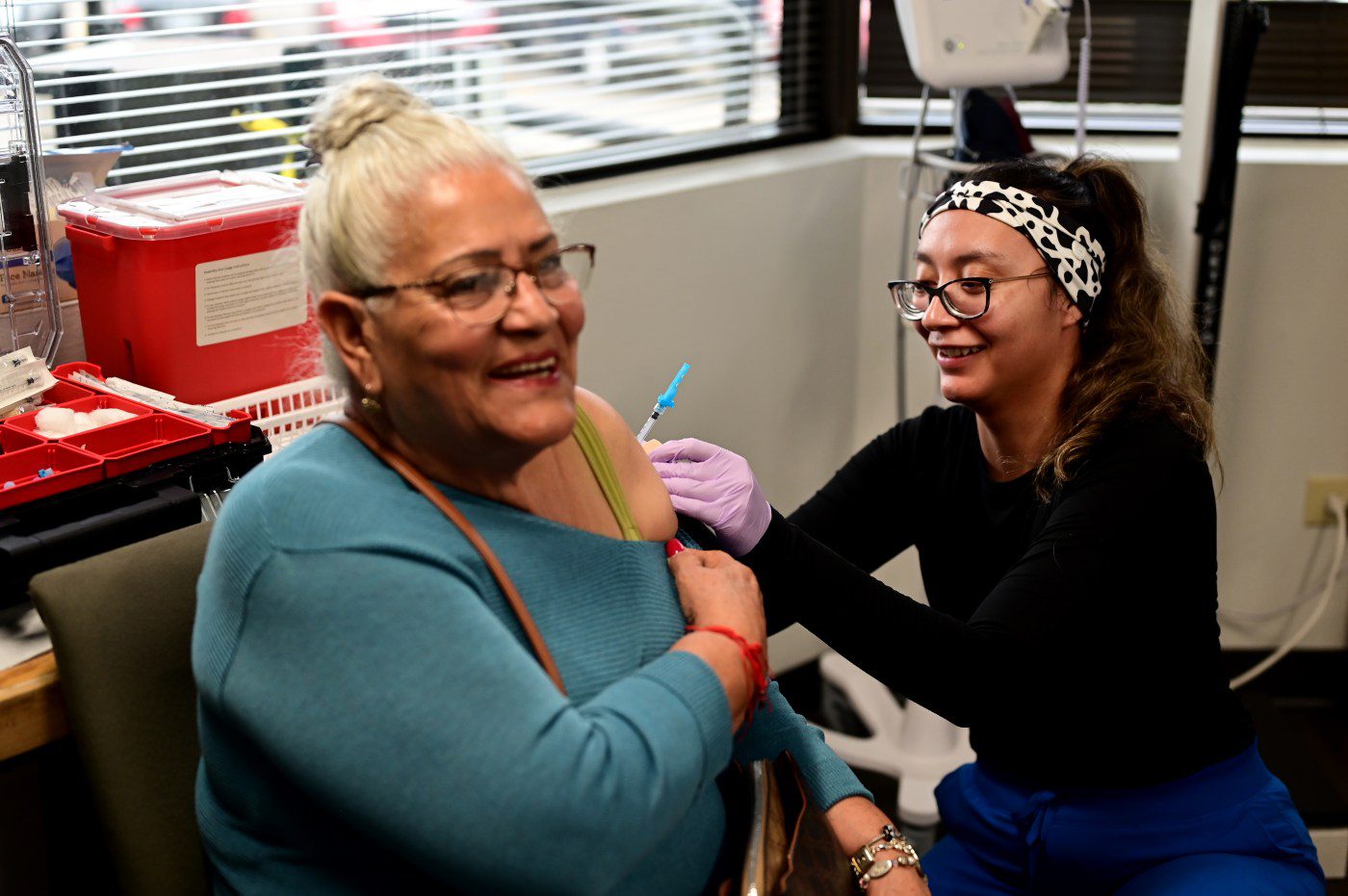Colorado is one of only three states where Latinos don’t outlive white residents, and liver disease, diabetes and overdoses are largely to blame.
Health researchers call it the “Hispanic paradox” that Latinos have lower age-adjusted mortality rates than the white, non-Hispanic population nationwide, despite having lower incomes and education levels, on average, as well as less access to health care. (Latinos can identify as white or any other race.)
Colorado, Hawaii and New Mexico are the only states that didn’t follow that pattern in 2022, which was the most recent year with full data.
The result wasn’t a one-time aberration: Year after year, Latinos have had a higher mortality rate than white residents in Colorado. Pre-pandemic, this state was one of only six where Hispanics were more likely to die prematurely. In 2022, Colorado had the second-largest disparity, behind Hawaii.
Since no one knows exactly what causes the paradox — though theories abound, including that healthy recent immigrants lift the average, or that tighter family connections help people manage poor health — pinning down why it doesn’t appear to help Colorado’s Latino population is doubly difficult.
But regardless of the causes, groups in and outside the health care mainstream in Colorado are working on reducing the biggest disparities.
In 2023, Latinos had higher age-adjusted death rates from 76 out of 122 causes tracked by the Colorado Department of Public Health and Environment, though not all of the differences reached statistical significance.
The biggest gaps were in deaths from liver disease (both alcohol-related and from all underlying causes), diabetes and accidental drug overdoses. Homicide and motor vehicle accidents also killed Latinos at a higher rate than white Coloradans.
In 2022, liver disease, diabetes and overdoses also contributed significantly to the mortality gap, though COVID-19 was the top driver of higher mortality among Latinos.
While everyone who identifies with Latin American ancestry is lumped together under the term Latino, Colorado has at least two distinct populations with different needs, said Claudia Amura, an assistant professor at the Colorado School of Public Health and the University of Colorado College of Nursing.
Latinos who live in the southern part of the state, particularly in the San Luis Valley, typically can trace their roots there for generations, and typically struggle with low incomes and a lack of places to get care, she said. The urban population, which generally arrived more recently, has more access to care, but may face language and cultural barriers.
“Not everybody may have the same access to services, the same needs,” she said.
“Societal problems” drive liver disease deaths
Hispanic Coloradans have about double the rate of liver disease deaths, adjusted for population size and age, that white Coloradans do. No state recorded a larger gap, though New Mexico wasn’t far behind, according to data compiled by the Centers for Disease Control and Prevention from 2018 to 2022.
If white Coloradans had an extremely low risk of dying of liver disease, a large gap might not point to a problem. But the state only ranks in the middle compared to other states’ white populations on overall liver disease, and is tied for the fifth-highest rate of deaths from alcohol-induced liver disease.
The top two causes of liver failure are excessive drinking and metabolic conditions that lead to fat build-up in the liver, said Dr. James Burton, who cares for patients before and after liver transplants at UCHealth’s Anschutz campus. Colorado’s Hispanic population does have a higher obesity rate than the white population — though the state has one of the lowest obesity rates in the country for both groups — but has a lower rate of unhealthy drinking, according to United Health Foundation’s annual America’s Health Rankings.
White Coloradans reported excessive drinking at one of the highest rates in the country, while Hispanic Coloradans were slightly less likely to report drinking at that level than the overall U.S. Hispanic population. The rankings defined excessive drinking as five or more drinks in one sitting or 15 or more drinks in a week for men, and four or more drinks in a sitting or eight or more in a week for women.
Liver disease typically doesn’t cause symptoms until the advanced stages, so people who don’t regularly see a doctor who might suggest testing or lifestyle changes don’t know they have a problem until they’re jaundiced and hospitalized — a situation more Latinos end up in because of barriers to health care, Burton said.
If the damage is too extensive for the body to repair itself, the only option is a liver transplant, which isn’t always feasible for people without health insurance and financial resources, he said.
“When I do see (liver patients), they’re often at the end stage, and it’s almost too late,” Burton said.
The liver transplant team is working on doing more outreach to the clinics that serve people without health insurance, to encourage them to assess patients’ liver health earlier, Burton said. They also are bringing their Spanish-speaking providers and staff together to do direct community outreach about caring for your liver and to help patients who aren’t comfortable with English to make it through the transplant process, he said. UCHealth has a similar program focused on kidney transplants, which slightly increased the number of Hispanic people receiving new organs.
But a hospital-based program can only do so much to prevent deaths from a disease that has so many links to people’s overall socioeconomic status, Burton said. As long as the state has disparities in who can afford healthy food and has access to treatment if they drink unhealthy amounts, it will also have disparities in liver disease deaths, he said.
“They’re societal problems,” Burton said.
Solutions have to match community
Colorado’s white population has one of the lowest rates of diabetes deaths in the country, coming in fourth behind the District of Columbia, Hawaii and Connecticut. But the state ranks among the 10 worst when it comes to the diabetes death rate among Latinos.
About 9.9% of Latinos in Colorado had a diabetes diagnosis as of 2019, compared to about 6.2% of white people — a 60% difference — according to America’s Health Rankings. Nationwide, the diabetes gap is about 10%, mostly because more white people have the disease.
Part of the problem is that the health care system doesn’t always meet the needs of Latinos, especially recent immigrants and those of Indigenous heritage, said Dr. Ricardo Gonzalez, who works with the nonprofit Servicios de la Raza and runs a public health clinic in the Mexican consulate in Glendale.
Even though providers are doing good work now, they’re up against distrust stemming from a long history of discrimination, Gonzalez said. In addition, the dominant Anglo-American idea of what good care looks like doesn’t always match what people from other cultures want, he said.
For example, in much of Latin America, health care is free, but people tend to only seek it out when they can tell something is wrong, Gonzalez said. They also aren’t accustomed to the idea of shared decision-making with their doctors or strict privacy laws limiting how much a provider can tell family members, he said.
“People would go when they were sick. They would not spend money to go to a regular checkup,” he said.
On top of that, people hesitate to get routine care because they fear surprise medical bills, worry about drawing attention to undocumented family members, or have trouble understanding all the forms their provider wants them to sign if they aren’t comfortable with English, Gonzalez said.
The clinic in the Mexican consulate is one partial solution, Gonzalez said. It doesn’t provide most medical care, but can screen people for diabetes, high blood pressure and HIV. Frequently, someone visiting the consulate for another reason who hadn’t seen a doctor in a long time will learn they have an undiagnosed condition that would continue to worsen without care, he said.
Ultimately, solutions will come from communities, but organizations that work most closely with people don’t have stable funding to build anything new, Gonzalez said. For example, the initial grant to staff the public health clinic at the consulate only lasted three years, and Servicios has to keep applying for new grants to staff it, he said.
“What we need is funding that is more sustainable, so the people can identify their own problems, we can guide them and they can find their own solutions,” he said.
Less drug use, yet more deaths
Colorado was among the 15 best states when it came to the rate of overdose deaths in the white population, but one of the 15 worst for deaths among Latinos.
But the gap doesn’t appear to be a reflection of who uses drugs. As of 2023, about 17% of Hispanic people and 22% of white people in Colorado reported nonmedical use of prescription drugs, or use of illicit drugs, other than marijuana. Despite reporting lower use, Latinos were more likely to seek out treatment for substance use disorder than people who didn’t identify as Hispanic, according to data from the Colorado Behavioral Health Administration. (The state’s data didn’t have a way to separate out white people who don’t identify as Hispanic from those who do.)
The state has made some progress in reaching Spanish speakers who use drugs or know someone who does, said Rica Rodriguez, executive director of Promotores de Esperanza, a group that offers harm reduction services and peer support to people starting off in recovery. As a person in recovery, Rodriguez said she noticed major gaps in what Latinos knew about harm reduction and how to access the overdose reversal drug naloxone, particularly if they weren’t comfortable speaking English.
In an average month, the group works with 30 to 45 mostly Spanish-speaking adults and youth in the Denver area, typically starting when they are in detox, Rodriguez said. But they also train organizations in other parts of the state about harm reduction and how to respond if someone overdoses, she said.
Because the group knows the community, they identified nightclubs popular with Denver’s Latino community and a liquor store in Commerce City as important partners in delivering naloxone, Rodriguez said. The display offering free doses at the liquor store is so popular that they have to restock it every Friday, she said.
Colorado’s recovery landscape still has gaps, such as sober living homes that don’t have a full-time Spanish-speaking employee, Rodriguez said. But she thinks the state has made progress in raising Latinos’ awareness of harm reduction and connecting people to resources, which hopefully will reduce overdose deaths.
“I really feel that we’re going in a good way,” she said.
Sign up for our weekly newsletter to get health news sent straight to your inbox.
Originally Published:





